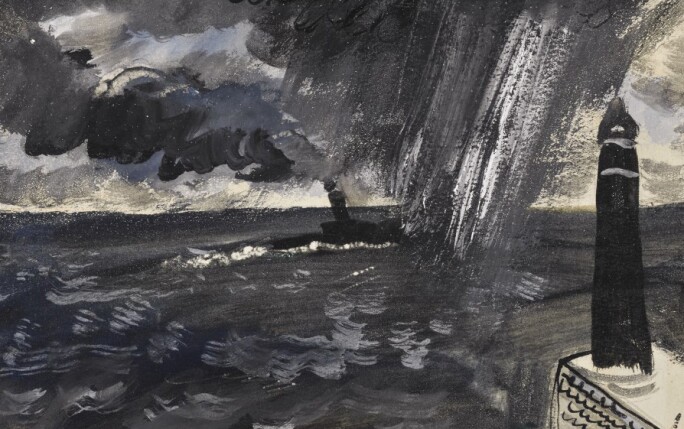W hen we think of Piper, we tend to think of his English churches and follies: strong images of ruined churches standing out against dramatic skies and often decorated with surprising colours and washes, which can sometimes obscure his skill as an observational artist and draughtsman. However, Piper always flirted with Modern art, and in the 1930s was influenced by Picasso, Braque and the French cubist movement. In 1933, he was elected to join the Seven and Five Society, whose members included Henry Moore, Barbara Hepworth, Christopher Wood and Ben Nicholson, all exploring modernism and the view that art stripped back to its essential elements becomes more meaningful and direct.
In this early period, Piper used collage with gouache and ink in a deliberately naïve, and often cubist, style with blocks of colour or collage representing seaside cliffs and beaches in tribute to his idols Picasso and Braque. This is something with which Ben Nicholson also experimented, though in a cleaner geometric modernist style. The results we see with Piper are rooted in a more homely British tradition, not only because of the subject matter of British coastal views, but also in the use of paper doilies and cut up newsprint which conjure up images of British seaside guest houses and tea rooms. In Harbour Scene, we see the paper doilies acting as net curtains, a vase of roses cut from a magazine, and the labels from a cigarette packet used to simulate the advert on the tobacconist shop in the foreground. The extensive use of black paint is also surprising and shows a confidence in his work.
Open for Bidding
In 1937, Piper wrote an article in which he identified the two most important, underlying subjects in his work. The first was a room, framed from a window, and the second was the structure on a beach, or as he called it the ‘beach-machine.’ This offered Piper both the possibility of man-made structures, such as the lighthouse, and also a vast range of inspiration from the changing natural climate of the beach and sea. In this example, he has added the drama of a sudden squall with a burst of isolated rain and a labouring vessel bellowing smoke. His subjects of marine views might be traditional, but they were never boring. The work is reminiscent of the Folk art found in Alfred Wallis’s maritime paintings but are more painterly and composed.
Piper says of his love affair with collage: "I carried about a portfolio full of torn and cut strips of paper of different colours, (and a variety of shades of the same colour) saved or picked up at random and in the heat of the moment, stuck or pinned insecurely, then applied more carefully at leisure in the studio." Piper’s Places: John Piper in England and Wales, 1983.
And his grandson Luke recalls: "In my grandfather’s studio, there was a drawer of newspaper cuttings, wrappers, labels, different types of card and paper (corrugated, perforated, stencilled or ornamental – some with metallic or textured effects) and paper doilies of various shapes, sizes and colours. There was a paper bag from a picnic in Brittany and the label from a can of sheep dip, which he found while sketching in the field." Luke Piper, November 2017 for a Tate Liverpool exhibition.
In the 1940s and 50s, Piper was an official war artist and was part of a scheme to record the British countryside and way of life as a memorial to the National War effort. His paintings of British churches, ruins and follies, traditional and romantic subjects but painted with a dash of abstraction in the colours and compositions, are the works for which he is now best known. The painter and curator Robin Ironside observed: "Among the artists to be considered here under the vague heading of "neo-romanticism", John Piper is, by temperament, most in tune with the national heritage... a romantic vision which, though still profiting from the lessons of abstraction, was distinctly descended from the English water-colourists of the late 18th and early 19th centuries''.
In the 1960s, Piper returned to collage and coastal views but these were more abstract than the works of the 1930s, with cut out shapes placed over washes mixed with oil, to give the effect of sand and sea merging, and distant vessels out at sea. At heart, he was an antiquarian, with a love of the British countryside and village churches, and always returned to observational painting . In this he can be compared to his contemporary, the poet John Betjamin, whose work showed a love of British tradition and village life centered around the church.
This painting came to Sotheby’s through the online request an estimate service on the Sotheby's website, the vendor having inherited it from his father who purchased it in the 1960s.
Do you have a family treasure you would like to have valued? Request an estimate.







